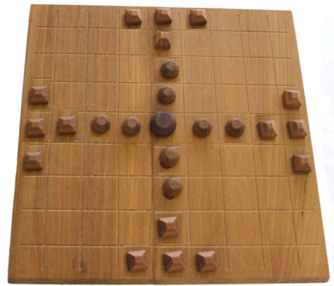
Donated to the Museum in 1981, this hardwood teak board was made in Denmark based on a game from Lapland. The reproduction set was designed by Piet Hein. The board is composed of pieces which fit together via a tongue and groove technique. It is 13.25cm x 13.26cm x 1.75cm thick.
The playing surface is a nine by nine matrix. Archeological finds indicate that the matrix for games of this type vary from 7 x 7 to 13 x 13 and larger. For more information about related game boards, click on the "Tafl Games" item in the left menu above.
Tablut is a "war game" in which a larger invading army attempts to capture the ruler of another country. Murray (History of Board Games, Oxford, 1952, pages 63-64) indicates that information about this game (with drawings) appears in the writings of the Swedish botanist Linnaeus under the date July 21, 1732. The "defenders" of the King are Swedes, and the "attackers" are Muscovites.
A square is stamped into each of the central three cells in the outer rows of each side of the board and center of the row in front of the outer row. These squares represent the camps of the invading army. In the center of the board, there is a pattern of nine depressions which represent the home area of the defenders.

The photograph at the right shows the playing pieces. They are stored in the suede bag on the right in the photograph. The playing pieces are rosewood. There are three types of playing pieces. There are 16 "invaders" shaped as squares which come to a point on the top of each one. There are approximately .75cm x 5cm. The "defenders" are cone shaped pieces (.57cm x 5cm) with flat tops. The "ruler" or "king" of the "defenders" (in the upper left of the photograph) is a larger round piece (1cm x .5cm) shaped like the other defenders.

The photograph on the left illustrates how the pieces are to be placed on the board to begin the game. Only the "king" can enter the central cell. If the "king" reaches any of the cells along the edge of the board, that player wins the game. If the "king" has a clear road to an edge cell, the opposing player must say "raichi"; if there are two clear roads he must say "tuichu". A piece is taken when an opponent piece occupies both adjacent cells in a row or column, but a piece can move to a cell between two cells in a row or column which are already occupied by opponent pieces without being taken. The "king" is captured if all four adjacent cells in a row and column are occupied by opponent pieces, and also when one adjacent cell is the central cell and the other three are held by the opponent pieces.
Last update March 2, 2010